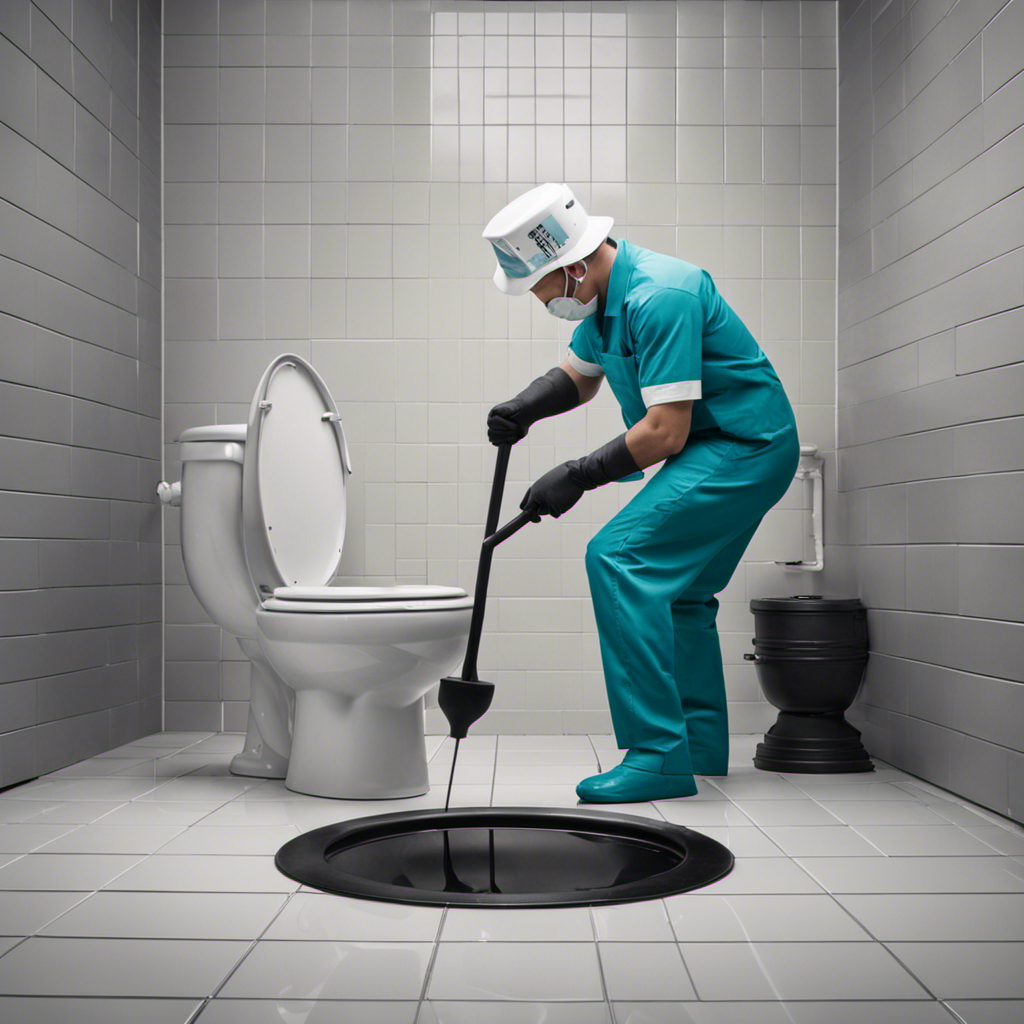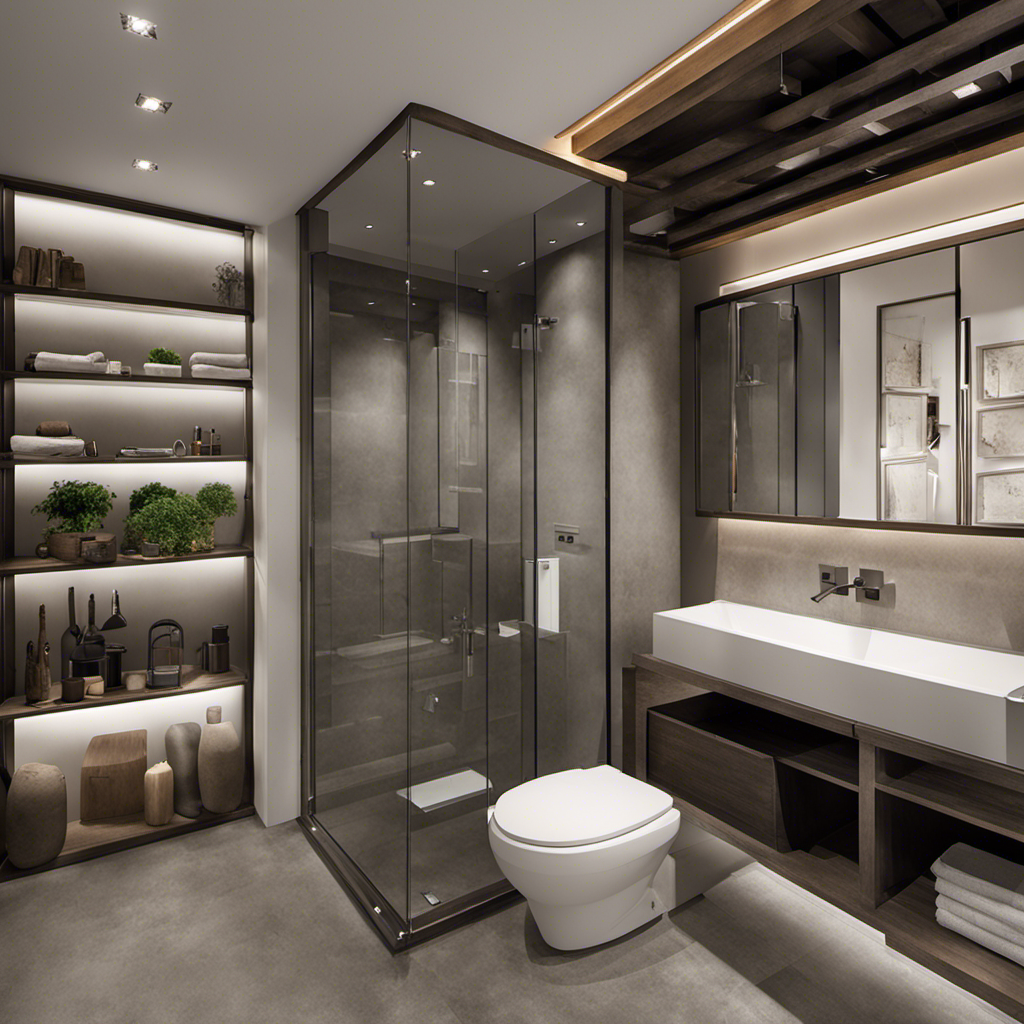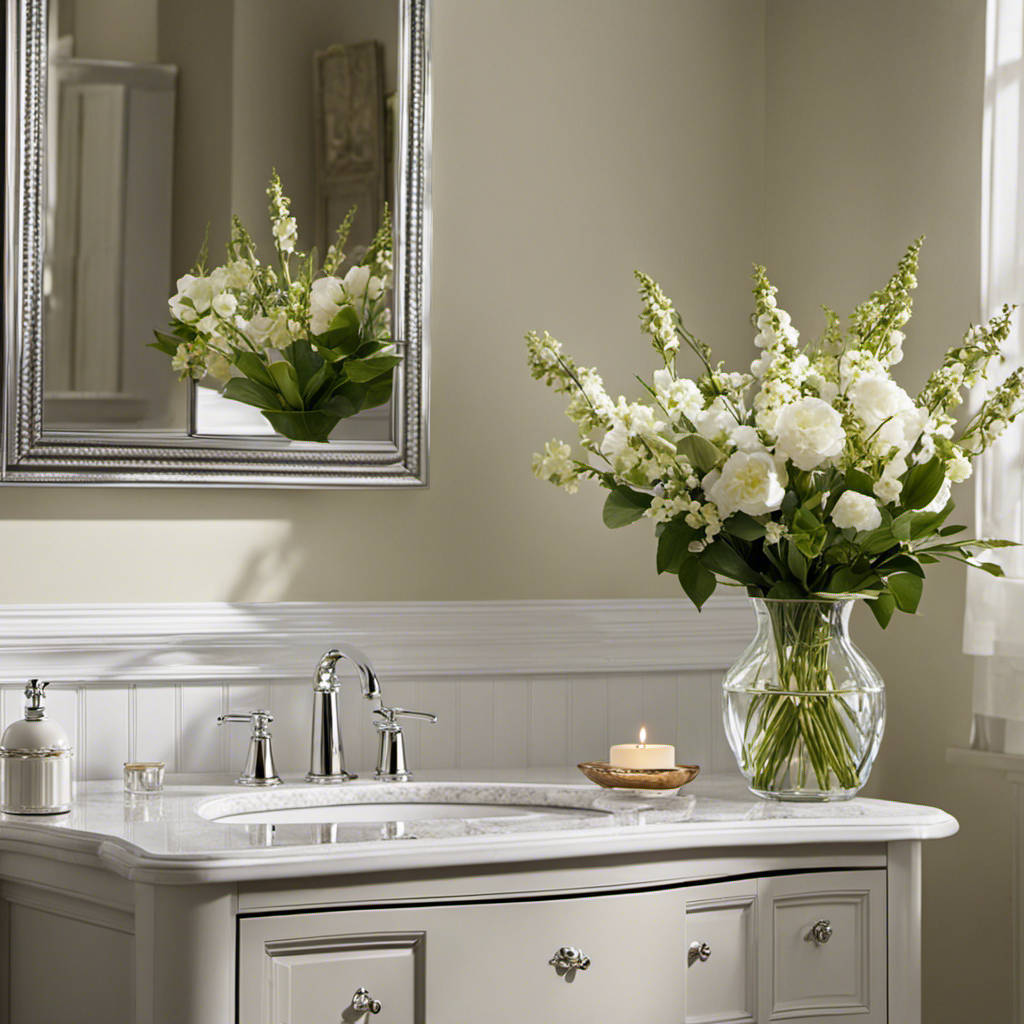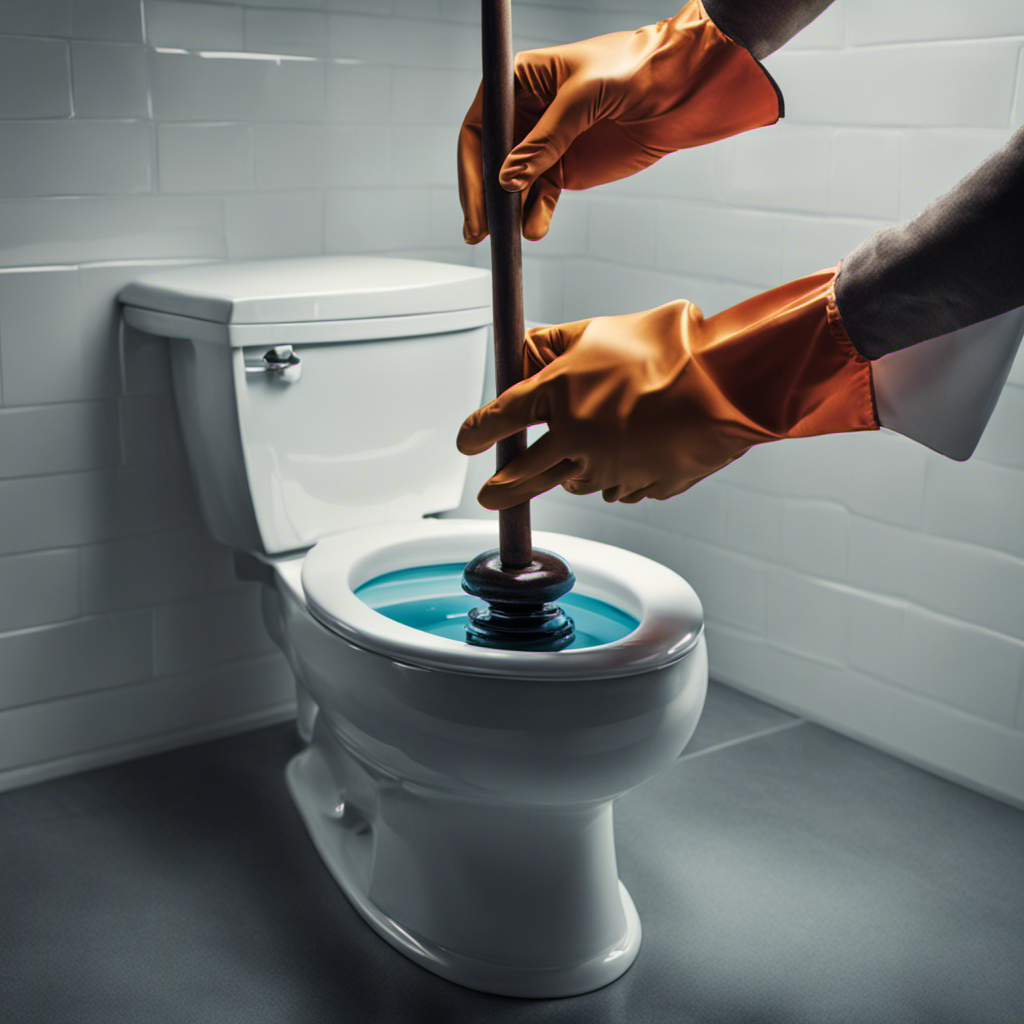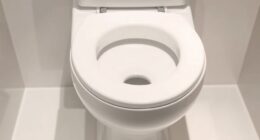I’ve got a secret to share with you: plunging a toilet doesn’t have to be a messy, frustrating ordeal. In fact, with the right technique and a little know-how, you can tackle this common household task like a pro.
In this article, I’ll guide you through the ins and outs of plunging a toilet correctly. From understanding the plunger and preparing the toilet, to troubleshooting and preventing future clogs, I’ve got you covered.
Get ready to say goodbye to toilet troubles once and for all.
Key Takeaways
- Regularly inspect and clean the rubber cup of the plunger
- Different types of plungers are available for specific purposes
- Clear the area around the toilet and gather necessary tools before plunging
- Proper hand positioning and pressure are crucial for effective plunging
Understanding the Plunger and Its Components
To understand how to plunge a toilet correctly, you need to familiarize yourself with the plunger and its components. Maintaining your toilet plunger is essential to ensure its effectiveness when the need arises.
Regularly inspect the rubber cup of the plunger for any cracks or tears, as this can affect its suction power. Clean the plunger thoroughly after each use to prevent the spread of germs and bacteria.
Additionally, there are different types of plungers available in the market, each designed for specific purposes. The most common type is the cup plunger, which is suitable for unclogging toilets and sinks. There are also flange plungers, which have an extra piece of rubber that fits into toilet drains with an added flange.
Preparing the Toilet for Plunging
Before you begin, make sure the area around the toilet is clear and you have the necessary tools.
To effectively plunge a toilet, you will need a plunger and possibly a toilet auger. The plunger is a common tool used to unclog toilets and consists of a rubber cup attached to a handle. The rubber cup creates a seal around the drain, allowing you to generate pressure and dislodge the clog.
The toilet auger, on the other hand, is a long, flexible tool with a coiled metal wire at the end. It is used for more stubborn clogs that cannot be cleared with a plunger.
Common causes of toilet clogs include excessive toilet paper, foreign objects, and the buildup of hair, soap scum, and mineral deposits.
Proper Plunging Technique
When it comes to proper plunging technique, there are a few key points to keep in mind.
First, hand positioning is crucial for effective plunging. Make sure to grip the handle firmly and position the suction cup directly over the drain opening.
Second, applying proper pressure is essential. Start with gentle, controlled plunges and gradually increase the force if necessary.
Lastly, it’s important to be mindful of the risk of overflow. To avoid this, periodically check the water level and adjust your plunging technique accordingly.
Correct Hand Positioning
Make sure you’ve got your hand positioned correctly on the plunger before you start plunging. Having the correct hand grip is crucial for effective plunging.
Many people make the mistake of gripping the plunger handle too high or too low, which can lead to a less efficient plunge. To ensure the correct hand positioning, follow these steps:
-
Hold the plunger handle with one hand, placing your thumb on the inside and your fingers on the outside of the handle.
-
Position your hand midway on the handle, so you have a firm grip without exerting too much pressure.
-
Keep your wrist straight and your arm extended, allowing for a smooth and controlled plunging motion.
By using the correct hand grip, you will have better control and generate more force to unclog the toilet effectively.
Applying Proper Pressure
To apply proper pressure while using the plunger, you’ll want to push down firmly and evenly on the handle. This ensures that the necessary force is applied to clear the clog effectively. Here are some key tips for pressure control and plunger maintenance:
-
Hold the plunger vertically: Position the plunger with the rubber cup facing downwards, ensuring a good seal against the drain.
-
Apply steady downward pressure: Push down firmly on the handle, using your body weight if necessary. Maintain this pressure throughout the plunging motion.
-
Avoid excessive force: While it’s important to apply enough pressure, avoid using excessive force as it may damage the plumbing or cause water to splash out.
-
Maintain a consistent rhythm: Create a steady, rhythmic motion by pushing and pulling the plunger in a controlled manner. This helps to dislodge the clog more effectively.
Avoiding Overflow Risk
Now that we’ve discussed applying proper pressure when plunging a toilet, let’s move on to another important aspect: avoiding the risk of overflow.
Overflow prevention is crucial to keep your bathroom clean and prevent water damage. One key factor to consider is the toilet water level. Before plunging, ensure that the water level is not too high. If it is, you can use a cup or bucket to remove some of the excess water. This will create more space for the plunging action and reduce the likelihood of water overflowing onto the floor.
Additionally, it’s important to plunge gently and gradually increase the force if needed. This approach will help dislodge the clog without causing a sudden surge of water that could lead to an overflow.
Troubleshooting Common Plunging Issues
First, check if there is any visible blockage in the toilet before attempting to plunge it. If there is, remove it using gloves or a disposable plastic bag. If there is no visible blockage, try these troubleshooting techniques to effectively plunge your toilet:
- Ensure a tight seal between the plunger and the drain hole.
- Use quick, forceful plunges to create a strong suction.
- Switch between vertical and horizontal plunging motions to dislodge the clog.
- Add hot water and dish soap to the toilet bowl to help break up the blockage.
If these techniques don’t work, there are alternative methods for unclogging a toilet, such as using a toilet auger or a homemade mixture of baking soda and vinegar. Remember to always follow safety precautions when attempting any plumbing repairs.
Preventing Future Toilet Clogs
When it comes to preventing future toilet clogs, there are a few key points to keep in mind.
First, it’s important to use proper flushing techniques, such as avoiding flushing excessive amounts of toilet paper or other non-flushable items.
Second, regular maintenance tips can help keep your toilet running smoothly, such as periodically checking and cleaning the jets and siphon holes.
Lastly, using drain-friendly products, like toilet bowl cleaners that are specifically designed not to clog pipes, can also contribute to preventing future clogs.
Proper Flushing Techniques
To ensure proper flushing, it’s important to firmly press down on the handle. This action activates the flushing mechanism, allowing water to flow into the toilet bowl and carry away waste. Here are some flashing techniques that can help ensure efficient flushing:
- Press down on the handle with enough force to activate the flush.
- Hold the handle down until you hear the toilet tank refill completely.
- If the toilet doesn’t flush properly, release the handle and wait for the tank to refill before trying again.
- Avoid flushing excessive amounts of toilet paper or foreign objects to prevent clogs.
By following these flashing techniques, you can maintain a properly functioning toilet and minimize the need for plunging. However, if a clog does occur, it’s essential to know how to plunge a toilet correctly.
Transitioning into the next section, I will provide some regular maintenance tips to keep your toilet in good working condition.
Regular Maintenance Tips
Regular maintenance is crucial for keeping your toilet in good working condition. By following a few simple tips, you can prevent clogs and keep your toilet functioning properly. Here are some regular maintenance tasks you should incorporate into your routine:
| Maintenance Task | Frequency |
|---|---|
| Check for leaks | Monthly |
| Clean the toilet bowl | Weekly |
| Inspect and replace parts | As needed |
Regularly checking for leaks is important to prevent water damage and wasted water. Cleaning the toilet bowl weekly helps prevent buildup and keeps your toilet looking and smelling fresh. Inspecting and replacing parts as needed ensures that your toilet is functioning at its best. By taking these steps, you can avoid costly repairs and keep your toilet in excellent working condition.
Using Drain-Friendly Products
Using drain-friendly products is a great way to prevent clogs and keep your plumbing system running smoothly. When it comes to maintaining a healthy and eco-friendly home, there are several options to consider. Here are a few eco-friendly alternatives and natural cleaning solutions:
- Baking soda and vinegar: This powerful combination can help break down grease and grime in your drains.
- Enzyme-based cleaners: These cleaners contain helpful bacteria that eat away at organic matter, effectively clearing clogs.
- Homemade drain cleaners: Mix equal parts of salt, baking soda, and hot water, and pour it down the drain to dissolve clogs.
- Mesh drain covers: These covers prevent hair, food particles, and other debris from entering your drains, reducing the risk of blockages.
By incorporating these drain-friendly products into your routine, you can minimize the chances of clogs and maintain a healthy plumbing system.
Now, let’s move on to additional tips and tricks for effective toilet plunging.
Additional Tips and Tricks for Effective Toilet Plunging
For even better results, you can try adding a little dish soap to the toilet bowl before you start plunging. Dish soap is a great alternative to chemical drain cleaners as it is eco-friendly and gentle on your plumbing system.
The dish soap works by lubricating the clog, making it easier to break up and flush away. Simply squirt a small amount of dish soap into the bowl, let it sit for a few minutes, and then start plunging. The soap will create a slippery surface, allowing the plunger to create a better seal and generate more suction.
This technique is especially effective for minor clogs and can be a useful addition to your unclogging routine. Remember to use a plunger with a flange, as it provides a better seal and increases plunging efficiency.
Frequently Asked Questions
How Often Should I Clean My Plunger?
I clean my plunger after every use to properly disinfect it. Signs of a dirty plunger include unpleasant odor and visible residue. Regular cleaning prevents the spread of bacteria and ensures effective plunging.
Can I Use a Plunger on a Clogged Sink or Bathtub?
When it comes to using a plunger on a clogged sink or bathtub, there are pros and cons to consider. It’s important to be knowledgeable about the technique and understand the potential outcomes.
What Should I Do if the Toilet Bowl Water Level Is Too Low to Effectively Plunge?
If the toilet bowl water level is too low, there are alternative methods to effectively repair it. These methods include using a toilet auger, hot water and dish soap, or a wet/dry vacuum.
Can I Use Chemical Drain Cleaners Before Plunging a Toilet?
I wouldn’t recommend using chemical drain cleaners in toilets. They can damage the plumbing and harm the environment. Instead, try using a plunger or other unclogging methods that don’t involve harmful chemicals.
How Long Should I Plunge the Toilet Before Determining That It Is Not Working?
I usually plunge the toilet for a few minutes before determining if it’s not working. It’s important to hold the plunger properly with a firm grip and use a steady up-and-down motion. To prevent toilet clogs, avoid flushing non-flushable items.
Conclusion
In conclusion, plunging a toilet correctly is a simple yet essential skill that everyone should know.
By understanding the plunger and its components, preparing the toilet properly, and using the correct plunging technique, you can effectively unclog your toilet and avoid further issues.
Troubleshooting common plunging problems and taking preventive measures will also help maintain a smoothly functioning toilet.
So, next time you find yourself in a sticky situation, remember that plunging a toilet is as easy as pie – just like fixing a flat tire on a bicycle!
